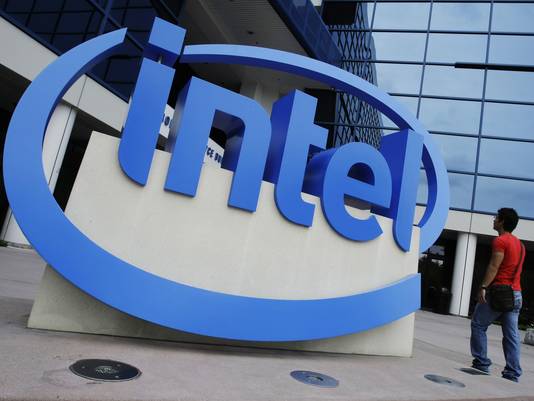The future will have Intel inside
Whether it's the smartphone we consult every five minutes, or the laptop that gets thinner each year, we're continuously reminded of the ways in which technology makes things smaller. What we sometimes forget is that it also allows us to build larger, and think bigger. Touchscreens have made possible both the tablet and the table PC. An iPhone will fit in your pocket, while a rumored Apple (AAPL[1]) television set will not.
The growth in handheld portable devices over the last decade has created a belief that power-efficiency is what defines a successful hardware manufacturer. The truth is more complicated. With machines becoming both larger and smaller, and serving more functions than ever before, what matters most is scalability. Intel Corp. (INTC[2]) understands this. The company is now aiming to do with processors what Microsoft (MSFT[3]) is trying to accomplish with Windows 8: to provide a continuous environment throughout the range of PC and post-PC devices. This would provide an efficiency for the company—one size fits all—and an attractive situation for software developers and original equipment manufacturers, who would enter a more integrated market.
In practical terms, this means designing a chip that can be scaled large or small, and built to emphasize either power-efficiency or performance. Later this year, Intel will release Haswell, an update of its Core line of processors—and Haswell will do just that. Intel is predicting as much as a doubling of battery life with the new chipset, and that's a big deal for the expanding market in Windows 8 tablet PCs and convertible notebooks. The next generation of these machines might offer life spans of 10 hours or more, at a performance level many times that of anything running ARM-based (ARMH) hardware. Ultrabooks—Intel's attempt to refresh an uninspired laptop market—could also get a new lease on life. Sales have been poor, as consumers see little reason to upgrade their computers, but Windows 8 and Haswell might be the team to change the ball game.
On the other hand, scalability only extends so far. The virtue of Intel's products is that they do many things well, and have few weakness. They offer a neutral environment for software developers, and an open one for the end-user. Chipsets built with ARM's architecture tend to be stronger in manufacturer-defined areas like graphics processing. Each approach is useful in its own way, and it's wrong to characterize the difference between them as one of efficiency. They're efficient at different things.
Intel has a natural advantage in PCs, where it can satisfy many different demands with a handful of product lines. It's cheaper to sell everyone a processor that does more than they need, if it means greater scale. Elsewhere, specialized hardware makes more sense. You are not, in any likely scenario, going to run spreadsheets on your smartwatch. And while the 4-inch screen on your iPhone is OK for watching videos, playing music, or reading tweets, it becomes a little sadistic the moment you have to actually input something. Size and battery life are limitations Intel has proven it can work with, but devices like these are additionally constrained by the fact that there are so many things you don't want to do on them. A more versatile CPU doesn't increase their usefulness, it just wastes power.
This has limited the success of Intel's low-powered Atom line of processors. They've gained some ground in tablets —where Haswell is likely to cannibalize them —and in niche areas like automobile consoles, but made almost no headway in smartphones. While the Atom is competitive on battery life and performance with the chips being offered by Nvidia (NVDA[4]) and Qualcomm (QCOM[5]), it's also larger and more costly, and Intel wastes its considerable advantages as a manufacturer trying to overcome these handicaps.
The company is fighting a foreign war, and one that it could have waged a lot more effectively had it never sold its ARM line, XScale, to Marvell Technology (MRVL[6]). It could be that the Atom was simply an attempt to buy time for improvements higher up the product chain, like the kind we're seeing with Haswell, and to prevent ARM from entrenching itself too deeply in tablets. If so, it was an expensive strategy.
It's also an unfortunate distraction, because Intel's efforts elsewhere may soon pay off—and at much better margins. The PC isn't dead, but it is moving beyond the beige box, and it's bringing with it the openness, and the limitless sense of freedom that made this the digital age. If Intel is suffering a crisis of confidence over the departure of CEO Paul Otellini, it shouldn't be. The future's bright, and it has Intel inside.
References
- ^ http://www.usatoday.com/money/lookup/stocks/aapl/ (www.usatoday.com)
- ^ http://www.usatoday.com/money/lookup/stocks/intc/ (www.usatoday.com)
- ^ http://www.usatoday.com/money/lookup/stocks/msft/ (www.usatoday.com)
- ^ http://www.usatoday.com/money/lookup/stocks/nvda/ (www.usatoday.com)
- ^ http://www.usatoday.com/money/lookup/stocks/qcom/ (www.usatoday.com)
- ^ http://www.usatoday.com/money/lookup/stocks/mrvl/ (www.usatoday.com)










